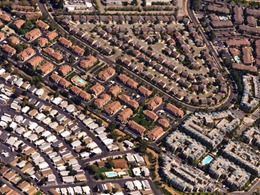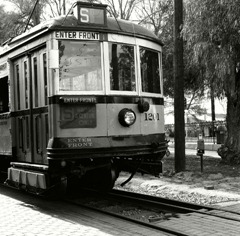How Cars Took Over American Life
 Part of us knows that cars drive us. We think we drive our cars, but as a nation, we are driven by our need to have and fuel our automobiles. Getting a driver’s license and owning a car is rite of American passage that is going global. More than any other single factor, this will make it increasingly difficult to limit the emissions that drive global warming. There are many elements to the story, including the near elimination of public transportation in all but the largest cities as an alternative mode in the middle of the Twentieth century. But the intrusion of the auto into American life was primarily fueled by the process of American suburbanization.
Part of us knows that cars drive us. We think we drive our cars, but as a nation, we are driven by our need to have and fuel our automobiles. Getting a driver’s license and owning a car is rite of American passage that is going global. More than any other single factor, this will make it increasingly difficult to limit the emissions that drive global warming. There are many elements to the story, including the near elimination of public transportation in all but the largest cities as an alternative mode in the middle of the Twentieth century. But the intrusion of the auto into American life was primarily fueled by the process of American suburbanization.
The first American suburbs were somewhat grand, laid out along the routes of local trains starting in the middle of the 19th Century. They were fairly wealthy towns, centered around their railroad stations, like Philadelphia’s Main Line. They consisted of large, well-built houses and even estates, paid for with the salaries of the prosperous business men who rode the trains to and from their offices in the cities. Although the town center remained around the station, it required a horse and buggy to get to the residents to their large and handsome homes from there.
Suburbs more like small towns started to appear around the turn of the Twentieth century, when they were built along the streetcar lines that radiated out from major cities — like Newton, near Boston. Because the fares for electric streetcars were low and the land outside of the center city relatively cheap, these towns were created by middle class families. Stores and other amenities  clustered around the trolley stops. Because the people who came to live there didn’t have other transportation, the distance of houses from the tram line had to be walkable, with closely spaced cross streets and alleyways between the houses that made it easy for residents to get to and from the trolley stop.
clustered around the trolley stops. Because the people who came to live there didn’t have other transportation, the distance of houses from the tram line had to be walkable, with closely spaced cross streets and alleyways between the houses that made it easy for residents to get to and from the trolley stop.
But what characterized these towns and differentiated them from the railroad suburbs and other towns that grew naturally around their populations was that these suburbs were mostly created by developers. Developers would buy land around a trolley line, lay it out, and build houses, just like developers do today. The houses might be finished to the buyer’s requirements, but the basic plan was already there. As people bought houses near someone they knew, the theoretical six degrees of separation tended to create communities from these developments.
While streetcar suburbs continued to grow, the proliferation of cars throughout the country in the Twenties created a demand for better roads and highways. These, in turn, encouraged people to move out of the city along the roads, filling in the areas between the radiating train and streetcar lines. Although this was the beginning of a car-dependent culture, there still remained an interest and emphasis on pedestrians, on their safety and convenience. As a result, towns like Radburn, N.J., although built as “towns for the motor age,” still had protected pedestrian ways and sidewalks, as well as parks and playgrounds.
The end of World War II was marked by the release of a pent-up demand for housing across the United States that flooded out from city and town centers. The Levitts and their Levittowns were the archetypal early developers who built entire towns as subdivisions rather than as organic towns. But the creation of the suburbs and subdivisions that carpeted the country from the Fifties on were as much a creation of other factors as the acumen of developers.
 One was the creation of highways that led Americans ever farther away from the centers of cities and towns. The Federal Highway Act of 1944 funded a network of highways and urban expressways that was cast across the country, encouraging development along the rights of way. In 1956, under President Eisenhower, this process was vastly accelerated, funding 41,000 miles of highways that carried Americans in their cars to subdivisions that were ever distant from center cities and towns.
One was the creation of highways that led Americans ever farther away from the centers of cities and towns. The Federal Highway Act of 1944 funded a network of highways and urban expressways that was cast across the country, encouraging development along the rights of way. In 1956, under President Eisenhower, this process was vastly accelerated, funding 41,000 miles of highways that carried Americans in their cars to subdivisions that were ever distant from center cities and towns.
Another major factor was the availability of mortgages. The Federal Housing Administration had in place a federal mortgage guarantee program that dated from the Thirties. The Servicemen’s Readjustment Act of 1944 provided the same guarantee to veterans. With low mortgage rates and guarantees for millions of home buyers, the demand for homes has turned millions of square miles into housing tracts.
There were new home building technologies that the developers adopted that enabled them to put up houses both cheaper and faster. As fast as the roads were built, subdivisions sprang up around them, houses were bought and funded. Every house now had a garage, or at least a carport and a driveway.
To live in these subdivisions, a car was not a choice but a necessity. The American mall moved shopping out to the suburbs, but they could only be reached by car. As jobs moved out to industrial parks, cars became essential to making a living . Schools followed, located where children had to be bused or driven. The family car’s – or cars’ – domination of life in the modern suburb was complete.


